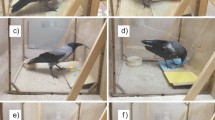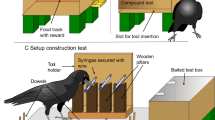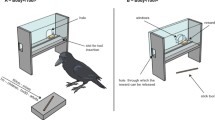Abstract
We investigated whether jungle crows can learn concepts by using printouts of shapes in a simultaneous two-alternative task. Jungle crows were first trained with a red triangle and red square until they reached the discrimination criterion (80 % of correct choices in two blocks of 10 trials each). Then, we tested crows with successive transfer tests to investigate both the discrimination cues being used and concept formation ability, by using novel triangular and non-triangular stimuli. All of the jungle crows learnt to discriminate between the triangle and square during training. The discrimination performance was generally not affected either by changes in the colour of the stimuli or when both shape and colour cues conflicted, with the previously non-rewarded shape but matching colour (red square) versus rewarded shape but non-matching colour (green triangle). The use of only outlines of the familiar stimuli also did not affect discrimination behaviour of crows. In addition, crows significantly discriminated novel triangular shapes during the limited trials given, suggesting their ability to form the concept of triangularity. However, failure to discriminate when the novel stimuli size deviated from the original suggests that there is a limit to shape concept formation in a familiar–novel context in the jungle crow.




Similar content being viewed by others
References
Astley SL, Peissig JJ, Wasserman EA (2001) Superordinate categorization via learned stimulus equivalence: quantity of reinforcement, hedonic value, and the nature of the mediator. J Exp Psychol Anim Behav Process 27:252–268
Baldwin BA (1979) Operant studies on shape discrimination in goats. Physiol Behav 23:455–459
Baldwin BA (1981) Shape discrimination in sheep and calves. Anim Behav 29:830–834
Bhatt RS, Wasserman EA, Reynolds WF, Knauss KS (1988) Conceptual behavior in pigeons: categorization of both familiar and novel examples from four classes of natural and artificial stimuli. J Exp Psychol Anim Behav Process 1:219–234
Bogale BA, Aoyama M, Sugita S (2011a) Categorical learning between ‘male’ and ‘female’ photographic human faces in jungle crows (Corvus macrorhynchos). Behav Process 86:109–118
Bogale BA, Kamata N, Mioko K, Sugita S (2011b) Quantity discrimination in jungle crows (Corvus machrorhynchos). Anim Behav 82:635–641
Cnotka J, Gunturkun O, Rehkamper G, Gray RD, Hunt GR (2008) Extraordinary large brains in tool-using new caledonian crows (Corvus moneduloides). Neurosc Let 433:241–245
Cook RG, Wright AA, Kendrick DF (1990) Visual categorization by pigeons. In: Commons ML, Herrnstein RJ, Kosslyn S, Mumford D (eds) Quant anal of behav, vol 8., Behavioral approaches to pattern recognition and concept formationLawrence Erlbaum, Hillsdale, NJ, pp 187–214
Dodwell PC (1957) Shape recognition in rats. Br J Psychol 48:221–229
Emery NJ (2006) Cognitive ornithology: the evolution of avian intelligence. Philos Trans R Soc B 361:23–43
Emery NJ, Clayton NS (2004) The mentality of crows: convergent evolution of intelligence in corvids and apes. Science 306:1903–1907
Giurfa M, Zhang S, Jenett A, Menzel R, Srinivasan MV (2001) The concepts of `sameness’ and `difference’ in an insect. Nature 410:930–933
Harlow HF (1944) Studies in discrimination learning by monkeys. I. The learning of discrimination series and the reversal of discrimination series. J Gener Psychol 30:3–12
Herrnstein RJ (1979) Acquisition, generalization, and discrimination reversal of a natural concept. J Exp Psychol Anim Behav Process 5:116–129
Herrnstein RJ, DeVilliers PA (1980) Fish as a natural category for people and pigeons. In: Bower GH (ed) The psychology of learning and motivation, vol 14. Academic Press, New York, pp 59–95
Herrnstein RJ, Loveland DH (1964) Complex visual concept in the pigeon. Science 146:549–551
Herrnstein RJ, Loveland DH, Cable C (1976) Natural concepts in pigeons. J Exp Psychol Anim Behav Process 2:285–302
Kirsch JA, Kabanova A, Güntürkün O (2008) Grouping of artificial objects in pigeons: an inquiry into the cognitive architecture of an avian mind. Brain Res Bull 75:485–490
Lazareva OF, Freiburger KL, Wasserman EA (2004) Pigeons concurrently categorize photographs at both basic and superordinate levels. Psychon Bull Rev 11:1111–1117
Minini L, Jeffery KJ (2006) Do rats use shape to solve “shape discrimination”? Learning Memory 13:287–297
Peissig JJ, Kimberly K, Young ME, Wasserman EA, Biederman I (2006) Effects of varying stimulus size on object recognition in pigeons. J Exp Psychol Anim Behav Process 32:419–430
Reynolds GS (1961) Attention in the pigeon. J Exp Anal Behav 4:203–208
Rosch E, Mervis CB, Gray WD, Johnson DM, Boyes-Braem P (1976) Basic objects in natural categories. Cogn Psychol 8:382–439
Sappington BF, Goldman L (1994) Discrimination learning and concept formation in the Arabian horse. J Anim Sci 72:3080–3087
Simrnova AA, Lazareva OF, Zorina ZA (2000) Use of number by crows: investigation by matching and oddity learning. J Exp Anal Behav 73:163–176
Tanaka M (2001) Discrimination and categorization of photographs of natural objects by chimpanzees (Pan troglodytes). Anim Cogn 4:201–211
Towe AL (1954) A study of figural equivalence in the pigeon. J Compa Physiol Psychol 47:283–287
Troje NF, Huber L, Loidolt M, Aust U, Fieder M (1999) Categorical learning in pigeons: the role of texture and shape in complex static stimuli. Vis Res 39:353–366
Vonk J, MacDonald SE (2002) Natural concepts in a juvenile gorilla (Gorilla gorilla gorilla) at three levels of abstraction. J Exp Anal Behav 78:315–329
Wasserman EA, Kiedinger RE, Bhatt RS (1988) Conceptual behavior in pigeons: categories, sub-categories, and pseudocategories. J Exp Psychol Anim Behav Process 14:235–246
Wasserman EA, DeVolder CL, Coppage DJ (1992) Non-similarity based conceptualization in pigeons via secondary or mediated generalization. Psychol Sci 6:374–379
Watanabe S (2010) Pigeons can discriminate “good” and “bad” paintings by children. Anim Cogn 13(1):75–85
Wilson B, Mackintosh NJ, Boakes RA (1985) Transfer of relational rules in matching and oddity learning by pigeons and corvids. Quart J Exp Psychol 37:313–332
Zentall TR, Wasserman EA, Lazareva OF, Thompson RKR, Rattermann MJ (2008) Concept learning in Animals. Comp Cogn Behav Rev 3:13–45
Acknowledgments
The research was supported by a Grant for Scientific Research from the Japan Society for the Promotion of Science (No. 23248053), the Japan Society for the Promotion of Science Postdoctoral Fellowship for Foreign Researchers (No. P12413) and a Grant for Scientific Research from Utsunomiya University Center for Optical Research and Education.
Ethical standard
Permits to trap jungle crows were obtained from Niiza city (permit for the catching of wild animals No. 01-02) and from the Tochigi prefecture (No. 0010). Permit to conduct the study was obtained from Utsunomiya University, and all procedures were performed in accordance with the ethical guidelines for the Care and Use of Laboratory Animals at Utsunomiya University (No. A10-0007).
Conflict of interest
We the authors of this paper entitled ‘Shape discrimination and concept formation in the jungle crow (Corvus macrorhynchos)’ hereby declare that we do not have a financial relationship and that there is no conflict of interest with any of the organizations that sponsored this research.
Author information
Authors and Affiliations
Corresponding author
Rights and permissions
About this article
Cite this article
Bogale, B.A., Sugita, S. Shape discrimination and concept formation in the jungle crow (Corvus macrorhynchos). Anim Cogn 17, 105–111 (2014). https://doi.org/10.1007/s10071-013-0642-y
Received:
Revised:
Accepted:
Published:
Issue Date:
DOI: https://doi.org/10.1007/s10071-013-0642-y




